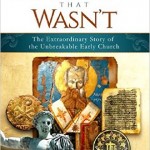There are two ways to look at the Church, two ways that are essential for a balanced Christian life; and I notice that many Catholics I read on-line seem to give more emphasis to one or the other.
The first is what I’ll call the Eternal View. People who emphasize this view (people like me) focus on the unchanging things of the Faith: the Divine, the truths of theology, the words of scripture. We study these things, and we think we have a pretty good handle on them, thank you very much. We also look at the precepts of the Church, and the duties that the Church assigns to us, and we make an effort to carry them out, and though we know we are imperfect, we think we do a pretty good job of them, thank you very much.
Any real accomplishment—and a working grasp of the Church’s orthodoxy and orthopraxy is certainly that—carries with it the possibility of sinful pride. In this case, it takes the form of thoughts like these:
- I bet those folks across the aisle don’t know as much about the Faith as I do.
- All I want is a reverent mass. How come those folks won’t shut up?
- How did these Cradle Catholics get to be so old without knowing this stuff?
- Bad catechesis! Bad catechesis!
- He’s not a Real Catholic, he’s just a Cultural Catholic.
- What can’t we all be on the same page?
Don’t think I’m knocking knowledge of the faith. Far from it. But I also know how I personally am led astray, and I can see it in others, too.
There’s another error here, also rooted in pride, which is to regard my current understanding of the Faith as normative for everyone. Because my current understanding of the Faith is necessarily incomplete, and because it inevitably includes a non-essential or two, most people are going to fall short. Once I start condemning others based on my imperfect understanding of the Faith, I’ve raised my understanding up into what Elizabeth Scalia calls a “super-idol”, and I begin to worship my intellect instead of my God.
A desire to be on the same page with other Catholics is a natural human thing. It’s what leads to the formation of religious orders, and friendships, and all manner of good things. But it can similarly lead us astray.
I think this is behind some of the angry sub-groups I see in the Church today. People who make an effort to seek out the Extraordinary Form of the Mass, for example, are birds of a feather: they are on the same page, and have similar notions of reverence, and so are comfortable together. There is nothing at all wrong with this: unless you assume that it’s how it ought to be for all Catholics. And then, when such a person attends a normal mass at a normal parish, look out!
That’s the first way, with some of the errors that can arise from it.
The second way is what I’ll call the Temporal View. People who emphasize this view focus on God in their fellow men and women, and on the journeys their fellows are making. There is only one God, and Jesus is the Way, the Truth and the Life; no one comes to the Father but through Him. But within that framework, there are as many ways to God as their are people. Everyone has his own journey: Jesus meets him where he is, and leads him by his own path.
Followers of this view seek to love their fellows with God’s love. And of course, this view has its own besetting sins, of which the most typical is dropping God out of the picture and loving the sin because you love the sinner. I’m not going to go into detail, though, because my problem is forgetting the Horizontal View, not over-emphasizing it. C.S. Lewis famously said that he only wrote about sins by which he was personally tempted, because those were the ones he understood. It’s much more satisfying and self-justifying (and much more typical) to write about sins to which you’re not tempted, because you can condemn them unequivocally; but although this is one of my temptations, I try to follow Lewis’ example.
So, for folks like me who tend to over-emphasize the Eternal View, here’s the point: except in small, self-selected groups, we ain’t never gonna all be on the same page, not this side of Heaven. Ain’t gonna happen. People come to the faith in different ways and different times. At every moment, children are being born. Every Sunday, some guy who who left the Church as a young man steps back through the door because there’s something he’s been missing. Every year, men and women who want to be married in the Church after previous mishaps go through RCIA, and learn enough to get by for a while. A normal parish is always going to be a chaotic mishmash of saints and sinners, the clued-in and the clueless, the wheat and the weeds. It simply is the way it is, and the sooner we stop railing about it, the sooner we’ll be able to start serving our brothers and sisters on different pages.
The Eternal View concerns the destination, the goal, the place where we should all be in the long run, the place to which God calls us. The Temporal View concerns everyone at their own points in the journey. Those of us for whom the Eternal View is more natural need to acquire the Temporal View as well, and learn to love and serve our brothers and sisters in Christ no matter where they are on the journey—and especially, those who have not yet begun the journey. Both views are necessary; as Jesus said (Matt 22:35-40):
And one of them, a lawyer, asked him a question, to test him. “Teacher, which is the great commandment in the law?” And he said to him, “You shall love the Lord your God with all your heart, and with all your soul, and with all your mind. This is the great and first commandment. And a second is like it, You shall love your neighbor as yourself. On these two commandments depend all the law and the prophets.”
And this is simply what Pope Francis is talking about. He’s not changing the Faith; he’s trying to get people like me to see the whole Faith.
You might also call the Eternal View the Vertical View; and the Temporal View the Horizontal View. And Jesus, well—you can always find Him where the Vertical meets the Horizontal.











